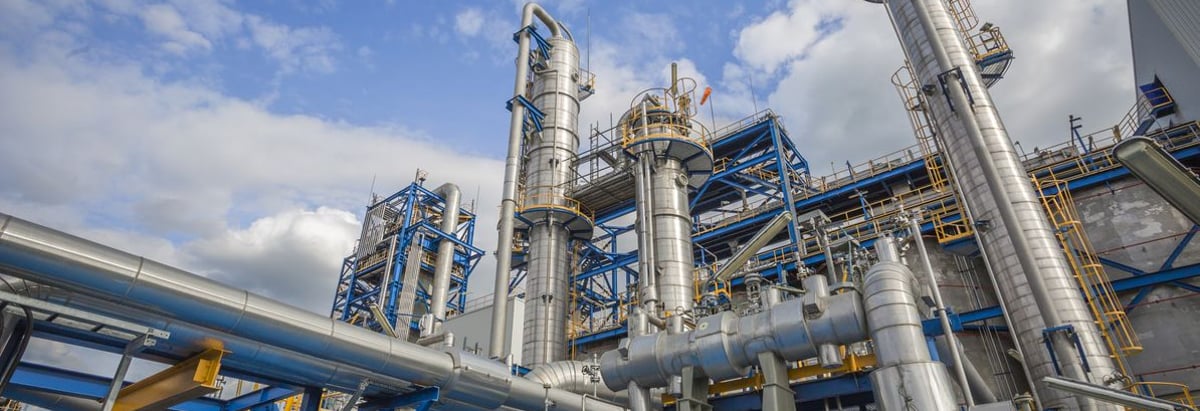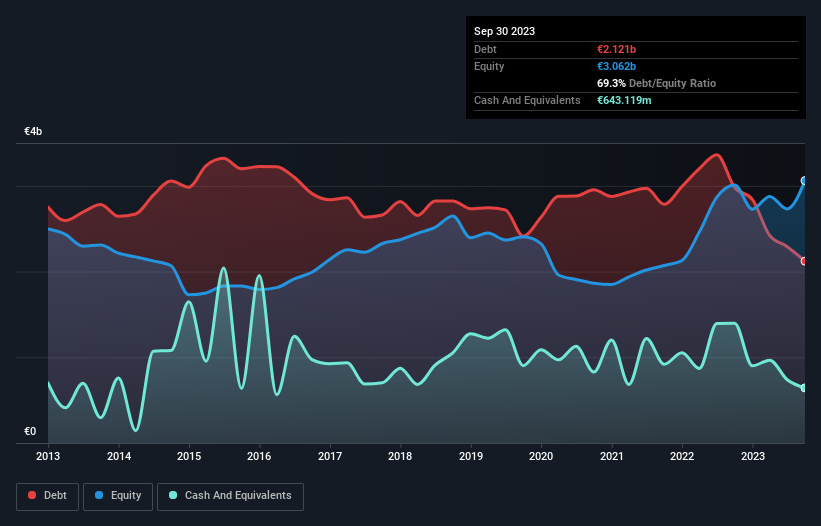- Greece
- /
- Oil and Gas
- /
- ATSE:ELPE
These 4 Measures Indicate That HELLENiQ ENERGY Holdings (ATH:ELPE) Is Using Debt Extensively

The external fund manager backed by Berkshire Hathaway's Charlie Munger, Li Lu, makes no bones about it when he says 'The biggest investment risk is not the volatility of prices, but whether you will suffer a permanent loss of capital.' It's only natural to consider a company's balance sheet when you examine how risky it is, since debt is often involved when a business collapses. We note that HELLENiQ ENERGY Holdings S.A. (ATH:ELPE) does have debt on its balance sheet. But the more important question is: how much risk is that debt creating?
When Is Debt Dangerous?
Debt is a tool to help businesses grow, but if a business is incapable of paying off its lenders, then it exists at their mercy. Part and parcel of capitalism is the process of 'creative destruction' where failed businesses are mercilessly liquidated by their bankers. However, a more usual (but still expensive) situation is where a company must dilute shareholders at a cheap share price simply to get debt under control. Of course, the upside of debt is that it often represents cheap capital, especially when it replaces dilution in a company with the ability to reinvest at high rates of return. When we think about a company's use of debt, we first look at cash and debt together.
See our latest analysis for HELLENiQ ENERGY Holdings
What Is HELLENiQ ENERGY Holdings's Debt?
You can click the graphic below for the historical numbers, but it shows that HELLENiQ ENERGY Holdings had €2.12b of debt in September 2023, down from €2.98b, one year before. However, it does have €643.1m in cash offsetting this, leading to net debt of about €1.48b.

How Strong Is HELLENiQ ENERGY Holdings' Balance Sheet?
According to the last reported balance sheet, HELLENiQ ENERGY Holdings had liabilities of €2.92b due within 12 months, and liabilities of €2.09b due beyond 12 months. Offsetting these obligations, it had cash of €643.1m as well as receivables valued at €890.2m due within 12 months. So its liabilities total €3.48b more than the combination of its cash and short-term receivables.
This deficit casts a shadow over the €2.22b company, like a colossus towering over mere mortals. So we definitely think shareholders need to watch this one closely. After all, HELLENiQ ENERGY Holdings would likely require a major re-capitalisation if it had to pay its creditors today.
We use two main ratios to inform us about debt levels relative to earnings. The first is net debt divided by earnings before interest, tax, depreciation, and amortization (EBITDA), while the second is how many times its earnings before interest and tax (EBIT) covers its interest expense (or its interest cover, for short). This way, we consider both the absolute quantum of the debt, as well as the interest rates paid on it.
While HELLENiQ ENERGY Holdings's low debt to EBITDA ratio of 1.5 suggests only modest use of debt, the fact that EBIT only covered the interest expense by 6.8 times last year does give us pause. But the interest payments are certainly sufficient to have us thinking about how affordable its debt is. In fact HELLENiQ ENERGY Holdings's saving grace is its low debt levels, because its EBIT has tanked 44% in the last twelve months. When it comes to paying off debt, falling earnings are no more useful than sugary sodas are for your health. There's no doubt that we learn most about debt from the balance sheet. But ultimately the future profitability of the business will decide if HELLENiQ ENERGY Holdings can strengthen its balance sheet over time. So if you're focused on the future you can check out this free report showing analyst profit forecasts.
Finally, a business needs free cash flow to pay off debt; accounting profits just don't cut it. So it's worth checking how much of that EBIT is backed by free cash flow. During the last three years, HELLENiQ ENERGY Holdings produced sturdy free cash flow equating to 51% of its EBIT, about what we'd expect. This cold hard cash means it can reduce its debt when it wants to.
Our View
To be frank both HELLENiQ ENERGY Holdings's level of total liabilities and its track record of (not) growing its EBIT make us rather uncomfortable with its debt levels. But at least it's pretty decent at managing its debt, based on its EBITDA,; that's encouraging. We're quite clear that we consider HELLENiQ ENERGY Holdings to be really rather risky, as a result of its balance sheet health. So we're almost as wary of this stock as a hungry kitten is about falling into its owner's fish pond: once bitten, twice shy, as they say. There's no doubt that we learn most about debt from the balance sheet. However, not all investment risk resides within the balance sheet - far from it. For instance, we've identified 4 warning signs for HELLENiQ ENERGY Holdings (1 shouldn't be ignored) you should be aware of.
If, after all that, you're more interested in a fast growing company with a rock-solid balance sheet, then check out our list of net cash growth stocks without delay.
Valuation is complex, but we're here to simplify it.
Discover if HELLENiQ ENERGY Holdings might be undervalued or overvalued with our detailed analysis, featuring fair value estimates, potential risks, dividends, insider trades, and its financial condition.
Access Free AnalysisHave feedback on this article? Concerned about the content? Get in touch with us directly. Alternatively, email editorial-team (at) simplywallst.com.
This article by Simply Wall St is general in nature. We provide commentary based on historical data and analyst forecasts only using an unbiased methodology and our articles are not intended to be financial advice. It does not constitute a recommendation to buy or sell any stock, and does not take account of your objectives, or your financial situation. We aim to bring you long-term focused analysis driven by fundamental data. Note that our analysis may not factor in the latest price-sensitive company announcements or qualitative material. Simply Wall St has no position in any stocks mentioned.
About ATSE:ELPE
HELLENiQ ENERGY Holdings
Operates in the energy sector in Greece, the Southeastern Europe, and the East Mediterranean.
Excellent balance sheet slight.
Market Insights
Community Narratives



